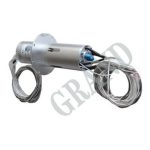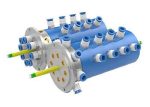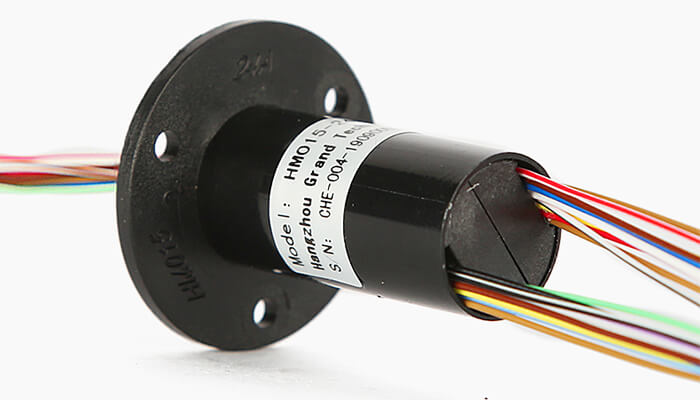A slip ring is a pivotal electromechanical device that allows the transmission of power and electrical signals from a stationary structure to a rotating one. Used across myriad sectors, they find their application in various fields like renewable energy, defense, manufacturing, and satellite communication systems, to name a few. The need for streamlined processes to produce, purchase, transport, and use these vital components brings us to the importance of the Harmonized System or HS codes.
HS codes are a globally recognized system of names and numbers used to classify traded products. Developed and maintained by the World Customs Organization (WCO), they’re key facilitators in international commerce, aiding in the clear identification, classification, and taxation of goods moving across global borders.
Thus, the HS code is not just a random sequence of numbers. It’s a standardized language that ensures that nations, manufacturers, traders, and customs officers are on the same page when it comes to identifying products under import or export. For products like slip rings, an understanding of the correct HS code is essential, ensuring that businesses navigate the complexities of international trade with seamless ease.
The complex interplay between specific product mechanisms and universal trade procedures is effectively exemplified through the integration of the concepts of electrical slip rings and their respective HS codes. Electrical slip rings, with their intricate operational design, symbolize the essence of product specificity. Simultaneously, the universality of trade practices is highlighted through the widespread use of the Harmonized System (HS) codes. The integration of these two — understanding the HS code of electrical slip rings — underlines the cohesive nature of global trading practices. As such, exploring these two areas in unison will not only deepen our knowledge but also allow us to maneuver through international commerce operations more adeptly.
Understanding HS Codes
The Harmonized System (HS) codes serve as the backbone of international trade, providing a universal language to classify and categorize a multitude of goods and products. To better grasp the significance of HS codes, let’s delve deeper into their definition, purpose, and usage, particularly in the context of international trade.
Definition, Purpose, and Usage
The HS codes, or Harmonized Commodity Description and Coding System, is a global standard developed by the World Customs Organization (WCO), encompassing over 98% of global trade. It’s a systematic and hierarchical structure based on a six-digit code that identifies and categorizes goods and products, simplifying customs and tariff procedures across borders.
The primary purpose of HS codes lies in facilitating smooth and efficient international trade by furnishing a consistent, organized, and recognizable means of product identification. These codes play a vital role in the import and export processes by:
- Streamlining customs documentation and clearance.
- Assigning tariffs, taxes, and duties based on product classification.
- Enforcing import and export controls, e.g., prohibited or restricted goods.
- Gathering and analyzing trade statistics for economic and policy decisions.
By ensuring transparency, uniformity, and precision in trade activities, HS codes have become indispensable tools for businesses, customs authorities, and governments worldwide.
The Role of HS Codes in Classifying Goods and Products
HS codes are integral to product classification in international trade. The HS code system comprises 21 sections, further divided into 99 chapters, 1,241 headings, and 5,205 subheadings. Each code is made up of six digits:
- The first two digits represent the chapter in which the product is classified.
- The following two digits correspond to the product’s heading within that chapter.
- The last two digits indicate the subheading under which the product falls.
This hierarchical system allows for accurate identification and classification of goods and products, ensuring they align with the appropriate tariff, tax, and regulatory requirements.
For instance, the code for an electrical slip ring can be found within the chapter related to electrical machinery and equipment, with each digit representing a more specific detail about the product. This hierarchical classification system is indispensable in international trade to ensure accurate communication and understanding of goods, benefiting businesses and customs authorities alike.

The HS Code for Slip Rings
The HS Code for slip rings delves into the intricate aspects of this electromechanical device, encapsulating every aspect, from them being a machine part to being a significant component in transmitting electrical signals.
When deciphering the HS code specific to slip rings, it’s essential to remember that the initial numbers are consistent globally, guiding us toward understanding the product’s main category. The more we move into the details of the code, the more specific and particular it gets about the features, uses, and unique aspects of the slip ring in focus.
Detailed Description of the HS Code Specific to Slip Rings
HS codes are made up of sections, chapters, headings, and subheadings furnished with numbers. The code for slip rings generally starts with the digits representing electrical machinery and equipment. The following digits would fall under a heading specific to electromechanical items, drawing it closer to the exact product we are laying focus on – slip rings.
Further down the line, the numbers increasingly become more specific, indicating distinct types and uses of slip rings, like those meant for aircraft, ships, or industrial turbines.
Explanation of How this Code Varies Between Countries and Why it’s Essential to Use the Correct Code
As the HS code becomes more specific, it starts reflecting the national variations determined by each country’s government bodies. Countries may add additional digits to the universal 6-digit code to further elaborate on the product’s features or uses aligning with their domestic tariff and statistical needs.
While the initial digits of an HS code for slip rings might be identical across borders, the complete HS code can be diverse. For example, the USA and China both employ a 10-digit HS code system, whereas the European Union uses an 8-digit system.
Understanding these variations and using the correct code is not just about compliance; it’s about streamlining communication in international trade. Misinterpretation or misuse of the code might result in incorrect tariff payments, customs penalties, or shipment delays, making the correct use of HS codes a crucial aspect of successful and efficient global trade operations.
What Is the HS Code of Electrical Slip Rings?
To obtain a clear understanding of the HS code for electrical slip rings, we must first unravel the structure of the code, which, as mentioned earlier, is composed of sections, chapters, headings, and subheadings. In this case, we will be focusing solely on electrical slip rings and the specific HS code that signifies them.
Identifying the HS Code
The HS code of electrical slip rings can be a six to ten-digit long number, depending on the country. The code typically begins with digits that signify electrical machinery and equipment, a category that encompasses slip rings. As we progress through the code, the numbers become more representative of the specific type of electrical slip ring.
For example, the initial six-digit HS code for electrical slip rings may be classified under electrical machines and apparatus, having individual functions. The following two to four digits, depending on the country, could refer to the type of slip rings and their functional application such as wind turbines, marine, or aerospace applications.
It’s important to note that the precise code might vary from one country to another, given that they follow different practices to add country-specific details on the nature, material, or function of the product. This information helps determine the tariffs and duties, as well as facilitating the collection of trade statistics.

The Importance of Coherent Context
When discussing the HS code for electrical slip rings, coherence in context is crucial. Recognizing the intricacies of the HS code system, as well as the difference between general electrical slip rings and subtypes, helps prevent confusion and misunderstandings during trade processes and customs clearance.
Furthermore, the coherence in context ensures seamless communication between trading partners, customs authorities, and logistics service providers for efficient international trade operations. Staying well-versed with both the global classification of electrical slip rings and country-specific sub-classification ensures hassle-free transactions, tariff determination, and legal compliance across borders.
Benefits of Correct HS Code
Understanding and applying the correct HS code for products, such as slip rings, is the cornerstone of seamless and successful international trade operations. The following sections provide a snapshot of the multiple benefits that accrue from the right usage of HS codes.
Facilitating Smooth International Trade
One of the most significant advantages of using the correct HS code is that it paves the way for smooth, efficient international trade. Transporting goods across borders involves numerous processes and requirements, and miscommunication can quickly result in time-consuming, costly errors and delays.
HS codes standardize the way we discuss and categorize goods internationally, providing a universally recognized language for countries, traders, and customs officers. With correct HS codes, communications are clear, import and export processes are streamlined, potential misunderstandings are avoided, and products reach their destination without hindrance — all contributing to the smooth operation of international trade.
Ensuring Proper Calculation of Taxes, Duties, and Tariffs
HS codes play a crucial role in determining the correct amount of taxes, duties, and tariffs that should be applied to goods. Customs authorities refer to these codes when calculating what levy should be charged on the import or export of a specific item.
For example, a slip ring required for a wind turbine would have a different HS code and subsequently different duty compared to one used in aerospace applications. Using the wrong HS code could lead to incorrect calculations, either resulting in overpayment or underpayment of associated charges – both of which could have serious implications for businesses.
Helping in Legal Compliance in International Shipping
HS codes don’t just facilitate trade and duty calculation; they’re also crucial for maintaining legal compliance during international shipping. Each country has its own set of regulations, guidelines, and laws concerning imported and exported goods.
Misclassification, under the wrong HS code, might not only come with financial penalties but can also aggregate into legal complications. Regulatory authorities, using HS codes, scrutinize goods ensuring that no banned, illegal, or restricted items are being transported.
For instance, certain types of slip rings used in highly regulated industries such as military and aerospace, might need special permissions or licenses to be imported or exported. The correct HS Code will help highlight these necessities, aid in adhering to the legal framework, and maintain the transparency and integrity of global trade.
HS Code for Slip Rngs Common User Concerns
The HS Code system, being a fundamental part of international trade, inevitably raises many queries from users. While the system has been designed to streamline global trade, its precise and intricate nature can sometimes be challenging to navigate. Here, we’ll address some common concerns relating to the HS Code for slip rings.
Concern: Variations in HS Code Between Countries
While the first six digits of the HS Code for slip rings are universally standardized, individual countries append additional digits to provide more specific information about the product. For instance, the U.S. uses a 10-digit system, while the E.U. uses an 8-digit code.
To illustrate, consider a slip ring used in wind turbines. In the U.S., there might be a 10-digit code specifically categorizing wind turbine slip rings, while in the U.K., a similar slip ring might fall under a different 8-digit code.

The challenge here is to ensure the correct HS Code is used for the specific country a business is trading with. This usage not only streamlines the customs process but also guarantees that the calculated duties and tariffs are accurate.
Concern: Updates in HS Code
HS Codes are not static and are revised every five years by the World Customs Organization to reflect changes in technology, global trade needs, and government policies. Firms must stay updated with revisions to the HS Code.
Let’s say an innovation introduces a new type of slip ring, previously not classified under the HS Code. Upon the next update, a new code might be introduced for this specific slip ring, which businesses need to adopt for their future trade operations.
Concern: Implications of Incorrect Code Usage
Incorrect usage of HS Codes can lead to severe implications such as incorrect tax and duty payments, customs clearance delays, or even legal issues.
For instance, if you mistakenly use the HS Code for general-purpose slip rings while exporting high-frequency slip rings used in medical equipment, it may result in less duty payment. However, if this error is caught during a customs audit, you might face financial penalties and legal consequences.
Ultimately, understanding and correctly using HS Codes is not just about compliance, but it plays a crucial role in ensuring smooth, efficient, and economically viable international trade operations.
Expert Tips on HS Code Compliance
Efficient use of HS codes not only ensures smooth operations in international trade but also helps prevent legal implications and financial discrepancies. As seasoned experts in the field of designing and manufacturing slip rings, we would like to share some valuable insights that can help companies maintain alignment with HS code regulations.
Insights from an Industry Pro
As a professional designing and manufacturing slip rings, understanding the nuances of your product is crucial when determining the correct HS code. A slip ring’s features and specifications such as its applications, rotational speed, type of signal, number of circuits, and design class should all be taken into account when classifying it under an HS code.
Say, for instance, you have designed a high-frequency slip ring for use in wind turbines. Understanding the specific functional attributes of your product leads to correct identification and use of the appropriate, fully-detailed HS code, ensuring your product is tracked accurately within the global trade system.
The Imperative of Compliance and Staying Updated
Staying compliant in the rapidly changing world of international trade presents numerous challenges, but none as integral as understanding and adopting updates to the HS code. The World Customs Organisation revises the HS system every five years, reflecting changes in global trade, technological advancements, and new product introductions.
Staying updated and adapting to these changes is not merely a regulatory requirement; it also presents an opportunity to contribute to the fine-tuning of your product specifications and gaining a competitive advantage in the market.
Tips for Ensuring Compliance
- Understand Your Product: Know your product in detail, especially features and functionality that align with your slip ring’s specific HS code.
- Stay Updated: Regularly check national and international customs sites for changes to the HS code assigned to your slip ring. Ensure you’re operating with the most recent information.
- Leverage Expertise: Reach out to international trade consultants or customs brokers who have in-depth knowledge and experience with HS code classification and compliance.
- Implement Good Record Keeping: Maintain comprehensive and accurate records of your product details and the corresponding HS codes used. Good documentation will be helpful in audits and verification processes.
By following these tips and staying diligent about HS code updates and their implications, you equip your business to sail smoothly through global trade currents, free from the worries of non-compliance and its associated repercussions.
Conclusion
Given the pivotal role played by slip rings in numerous applications, understanding the HS Code for these components is critical for any industry professional. Be it for ensuring smooth international trade, accurate tax calculations, or ensuring legal compliance, a solid grasp of the HS codes and their implications is indispensable.
Further Resources
The ever-evolving landscape of international trade requires constant learning and staying updated. The HS Code, being a dynamic component of this landscape, necessitates regular checks for updates. To assist you in this process, we’ve compiled some accessible resources and suggestions for where to seek help in uncertain situations.
Staying Updated on HS Code Changes
- World Customs Organization (WCO): The WCO is the governing body responsible for the Harmonized System and for issuing updates to the HS codes. Their official website is the principal source for any changes and revisions.
- Customs and Border Protection Websites: Individual country customs sites like the U.S. Customs and Border Protection’s official website regularly post updates related to HS Codes.
- Trade Journals and Associations: Subscribing to journals like the Journal of Commerce or being a part of trade associations in your industry can also keep you updated on changes in HS codes.
Seeking Help in Uncertainty
- Customs Brokers and Consultancies: Customs brokers and international trade consultancies are equipped with expertise to help businesses navigate the complexities of HS codes. Companies like Sandler, Travis & Rosenberg, P.A. specializes in customs and international trade law.
- Trade Advisors: Many governments, like the U.S. and U.K., provide trade advisory services for businesses involved in import/export. The U.S. has Trade Information Centers, and the U.K. has an International Trade Administration.
- Online Forums and Platforms: There are online platforms such as the International Trade Centre that allow users to discuss their queries related to HS Codes.
Remember, staying informed about the HS Code changes is as much a part of your business operations as development and distribution. There are multiple resources available to ensure you stay on top of these updates and get help when in doubt, ultimately ensuring seamless and compliant international trade operations.
See What We Can Do

